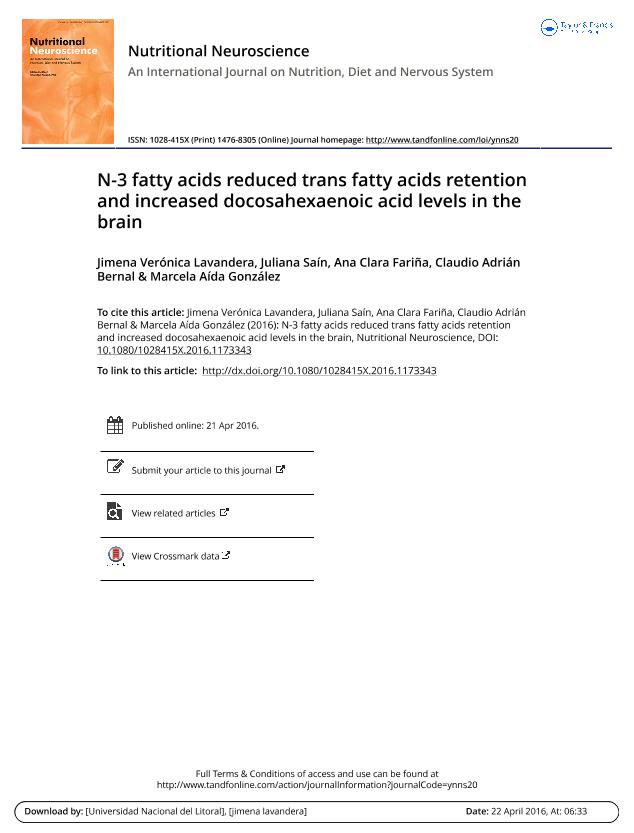Mostrar el registro sencillo del ítem
dc.contributor.author
Lavandera, Jimena Veronica

dc.contributor.author
Sain, Juliana

dc.contributor.author
Fariña, Ana Clara

dc.contributor.author
Bernal, Claudio Adrian

dc.contributor.author
González, Marcela Aída

dc.date.available
2018-08-17T16:55:13Z
dc.date.issued
2017-08
dc.identifier.citation
Lavandera, Jimena Veronica; Sain, Juliana; Fariña, Ana Clara; Bernal, Claudio Adrian; González, Marcela Aída; N-3 fatty acids reduced trans fatty acids retention and increased docosahexaenoic acid levels in the brain; Maney Publishing; Nutritional Neuroscience; 20; 7; 8-2017; 424-435
dc.identifier.issn
1028-415X
dc.identifier.uri
http://hdl.handle.net/11336/56178
dc.description.abstract
Introduction: The levels of docosahexaenoic acid (DHA, 22:6n-3) and arachidonic acid (AA, 20:4n-6) are critical for the normal structure and function of the brain. Trans fatty acids (TFA) and the source of the dietary fatty acids (FA) interfere with long-chain polyunsaturated fatty acids (LC-PUFA) biosynthesis. Objectives: The aim of this study was to investigate the effect of TFA supplementation in diets containing different proportions of n-9, n-6, and n-3 FA on the brain FA profile, including the retention of TFA, LC-PUFA levels, and n-6/n-3 PUFA ratios. These parameters were also investigated in the liver, considering that LC-PUFA are mainly bioconverted from their dietary precursors in this tissue and transported by serum to the brain. Also, stearoyl-CoA desaturase-1 (SCD1) and sterol regulatory element-binding protein-1c (SREBP-1c) gene expressions were evaluated. Methods: Male CF1 mice were fed (16 weeks) diets containing different oils (olive, corn, and rapeseed) with distinct proportions of n-9, n-6, and n-3 FA (55.2/17.2/0.7, 32.0/51.3/0.9, and 61.1/18.4/8.6), respectively, substituted or not with 0.75% of TFA. FA composition of the brain, liver, and serum was assessed by gas chromatography. Results: TFA were incorporated into, and therefore retained in the brain, liver, and serum. However, the magnitude of retention was dependent on the tissue and type of isomer. In the brain, total TFA retention was lower than 1% in all diets. Discussion: Dietary n-3 PUFA decreased TFA retention and increased DHA accretion in the brain. The results underscore the importance of the type of dietary FA on the retention of TFA in the brain and also on the changes of the FA profile.
dc.format
application/pdf
dc.language.iso
eng
dc.publisher
Maney Publishing

dc.rights
info:eu-repo/semantics/openAccess
dc.rights.uri
https://creativecommons.org/licenses/by-nc-sa/2.5/ar/
dc.subject
Brain
dc.subject
Corn Oil
dc.subject
Fatty Acids Profile
dc.subject
Long-Chain Polyunsaturated Fatty Acids
dc.subject
Olive Oil
dc.subject
Rapeseed Oil
dc.subject
Trans Fatty Acids
dc.subject.classification
Salud Ocupacional

dc.subject.classification
Ciencias de la Salud

dc.subject.classification
CIENCIAS MÉDICAS Y DE LA SALUD

dc.title
N-3 fatty acids reduced trans fatty acids retention and increased docosahexaenoic acid levels in the brain
dc.type
info:eu-repo/semantics/article
dc.type
info:ar-repo/semantics/artículo
dc.type
info:eu-repo/semantics/publishedVersion
dc.date.updated
2018-08-16T17:37:30Z
dc.journal.volume
20
dc.journal.number
7
dc.journal.pagination
424-435
dc.journal.pais
Reino Unido

dc.journal.ciudad
Londres
dc.description.fil
Fil: Lavandera, Jimena Veronica. Consejo Nacional de Investigaciones Científicas y Técnicas; Argentina. Universidad Nacional del Litoral. Facultad de Bioquímica y Ciencias Biológicas. Departamento de Ciencias Biológicas. Cátedra de Bromatología y Nutrición; Argentina
dc.description.fil
Fil: Sain, Juliana. Consejo Nacional de Investigaciones Científicas y Técnicas; Argentina. Universidad Nacional del Litoral. Facultad de Bioquímica y Ciencias Biológicas. Departamento de Ciencias Biológicas. Cátedra de Bromatología y Nutrición; Argentina
dc.description.fil
Fil: Fariña, Ana Clara. Consejo Nacional de Investigaciones Científicas y Técnicas; Argentina. Universidad Nacional del Litoral. Facultad de Bioquímica y Ciencias Biológicas. Departamento de Ciencias Biológicas. Cátedra de Bromatología y Nutrición; Argentina
dc.description.fil
Fil: Bernal, Claudio Adrian. Consejo Nacional de Investigaciones Científicas y Técnicas; Argentina. Universidad Nacional del Litoral. Facultad de Bioquímica y Ciencias Biológicas. Departamento de Ciencias Biológicas. Cátedra de Bromatología y Nutrición; Argentina
dc.description.fil
Fil: González, Marcela Aída. Universidad Nacional del Litoral. Facultad de Bioquímica y Ciencias Biológicas. Departamento de Ciencias Biológicas. Cátedra de Bromatología y Nutrición; Argentina
dc.journal.title
Nutritional Neuroscience

dc.relation.alternativeid
info:eu-repo/semantics/altIdentifier/doi/https://dx.doi.org/10.1080/1028415X.2016.1173343
dc.relation.alternativeid
info:eu-repo/semantics/altIdentifier/url/https://www.tandfonline.com/doi/full/10.1080/1028415X.2016.1173343
Archivos asociados
